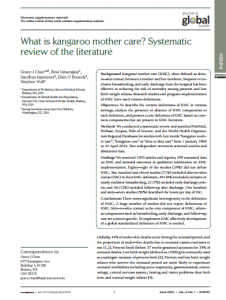
Background
Kangaroo mother care (KMC), often defined as skin– to–skin contact between a mother and her newborn, frequent or exclusive breastfeeding, and early discharge from the hospital has been effective in reducing the risk of mortality among preterm and low birth weight infants. Research studies and program implementation of KMC have used various definitions.
Objectives
To describe the current definitions of KMC in various settings, analyze the presence or absence of KMC components in each definition, and present a core definition of KMC based on common components that are present in KMC literature.
Methods
We conducted a systematic review and searched PubMed, Embase, Scopus, Web of Science, and the World Health Organization Regional Databases for studies with key words “kangaroo mother care”, “kangaroo care” or “skin to skin care” from 1 January 1960 to 24 April 2014. Two independent reviewers screened articles and abstracted data.
Findings
We screened 1035 articles and reports; 299 contained data on KMC and neonatal outcomes or qualitative information on KMC implementation. Eighty–eight of the studies (29%) did not define KMC. Two hundred and eleven studies (71%) included skin–to–skin contact (SSC) in their KMC definition, 49 (16%) included exclusive or nearly exclusive breastfeeding, 22 (7%) included early discharge criteria, and 36 (12%) included follow–up after discharge. One hundred and sixty–seven studies (56%) described the hours per day of SSC.
Conclusions
There exists significant heterogeneity in the definition of KMC. A large number of studies did not report definitions of KMC. Skin–to–skin contact is the core component of KMC, whereas components such as breastfeeding, early discharge, and follow–up care are context specific. To implement KMC effectively development of a global standardized definition of KMC is needed.